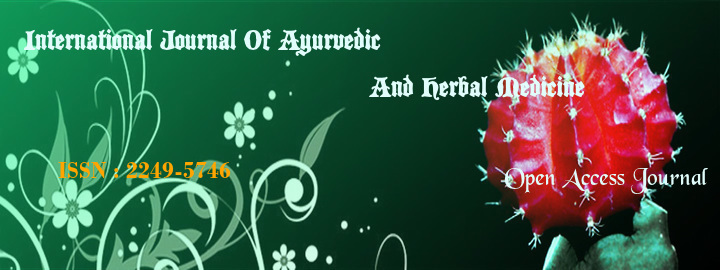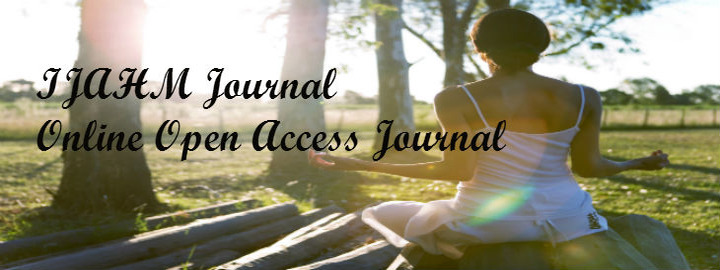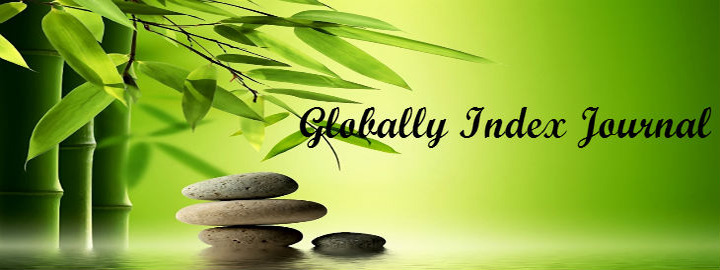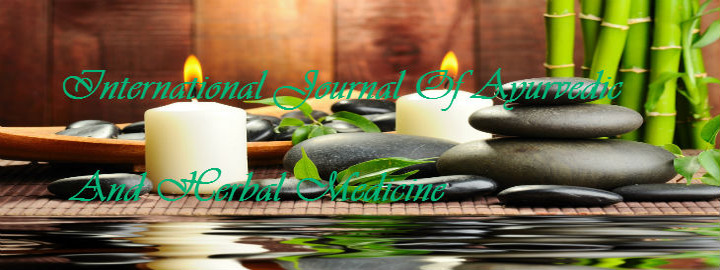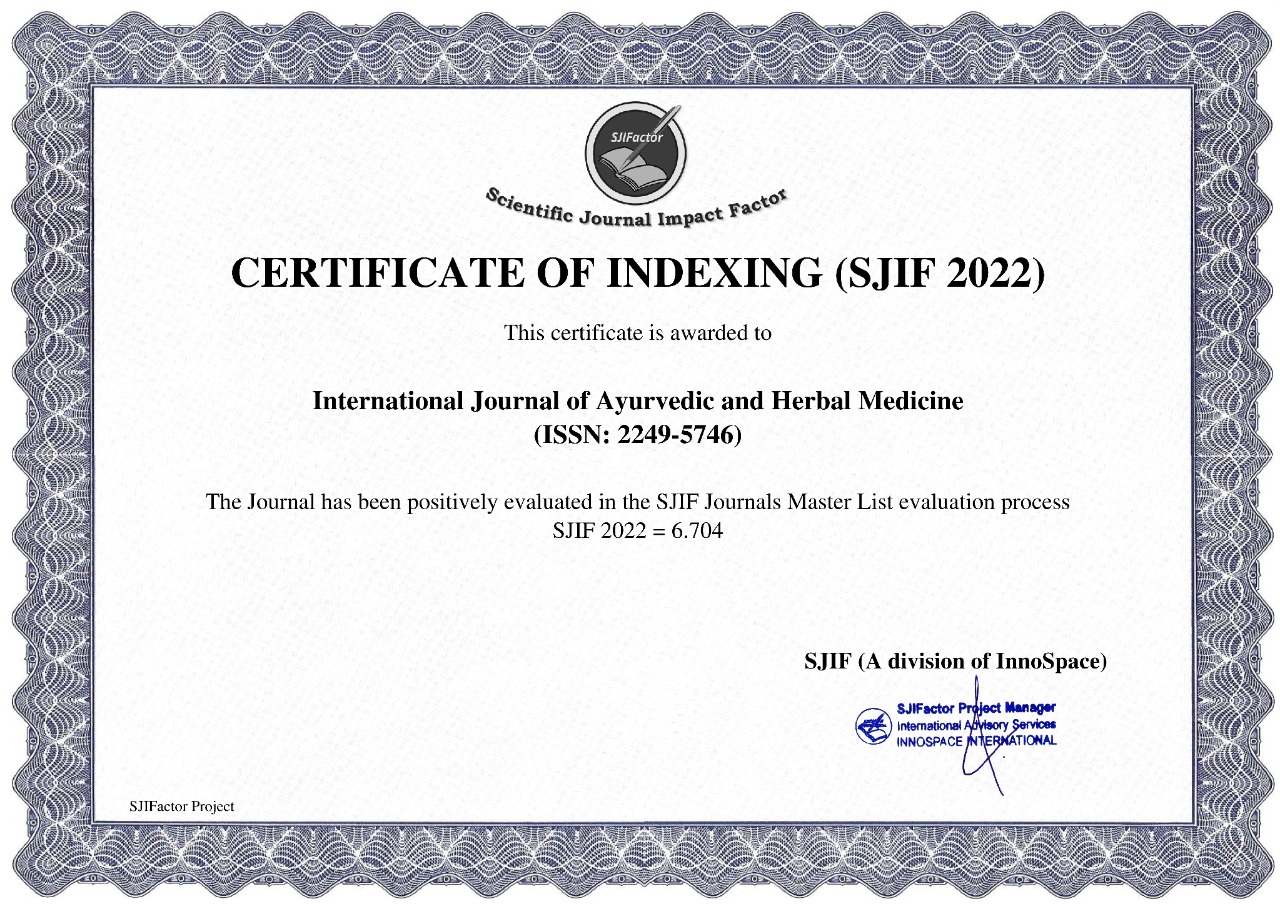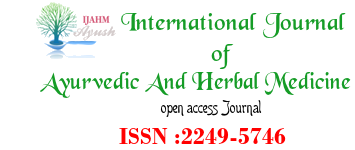


Volume & Issue : Volume 4 Issue 5
|
Dr. Sonawane Suvarna Rambhau*, Dr. Deshpande Pradnya Ravindra, Dr. Pande Prasad Prabhakharrao, Dr. Shahane Vijay Chandrakant. PMT’s Ayurved College, Shevgaon; Dist-Ahmednagar (MS). *Corresponding Author : Email ID : This email address is being protected from spambots. You need JavaScript enabled to view it.. |
Abstract
The World Health Organisation (WHO) estimated that 80% of the population of developing countries rely on traditional medicines, mostly plant drugs, for their primary health care needs. Agnimantha [Clerodendrum phlomidis Linn.f. Syn. C. multiflorum (Burm.f.) O.kuntze, Clerodendrum phlomoides Linn.f.], family verbenaceae, is one of the ingredient of Dashamoola1. In traditional systems of medicine, leaves, stem, aerial parts and root of the plant are used in Shotha (inflammation), Prameha (glycosuria), Jwara (coryza), Upadamsha (gonorrhea), Sthaulya (obesity) etc. Various research has been carried out for isolation of chemical constituents and therapeutic potential of Clerodendrum phlomidis. This review is an attempt to compile the phytochemical and pharmacological activity Of Clerodendrum phlomidis.
Key word
Agnimantha, Clerodendrum phlomidis, chemical constituents, pharmacological activity
REFERANCES
1. 1. Dr. Chunekar KC, Dr. Pandey GS. Bhavaprakasha Nighantu, Chaukhamba Bharati Academy, Varanasi, reprint 1999, 294.
2. Dr. Kirtikar KR and Basu BD. Indian Medicinal Plants; Edn 2, Vol. III ,International Book Distibutors, Deharadun; 1975, 1947-1948.
3. The Ayurvdic Pharmacopoeia of India, Part-2, Vol 1, Formulations. 1sted. New Delhi: Govt. of India, Ministry of Health & Family welfare; 2007, 3-4.
4. Sharma PC, Yelne MB, Denis TJ. Database of Medicinal Plants used in Ayurveda, Vol.2, CCRAS, Reprint 2005, 1.
5. The Ayurvedic Formulary of India, Edn 2, Vol. III, Part-I, New Delhi: Govt. of India, Ministry of Health and Family welfare; 2000.
6. Nandkarni KM. Indian Materia Medica, Edn 3, Vol. I, Popular Prakashan, Mumbai, 2007, 353.
7. Joshi KC et al. A Chemical investigation of the roots of different Clerodendron species. Planta Med 1979; 37: 64-66.
8. Anam EM. Novel flavanone and chalcone glycosides from Clerodendron phlomidis (Verbanaceae). Indian J Chem 1999; 38B(10) : 1307-1310.
9. Gupta SK et al. Chemical examination of Clerodendron phlomidis. Indian J Pharm 1967; 28 : 102.
10. Pandey R et al. Lupeol ester from Clerodendrum phlomidis L. Indian J Chem 2008; 47B(3) : 470-472.
11. Bhakuni DS et al. Chemical examination of Clerodendron phlomidis Linn. J Sci Indust Res 1962; 21B: 48-49.
12. Subramanian SS et al. Scutellarein and pectolinaringenin from the leaves of Clerodendron phlomides and Duranta repens. Phytochemistry 1972; 11(10) : 3095-3096.
13. Subramanian SS et al. (24S)-ethylcholesta-5,22,25-triene-3β-ol from four Clerodendron species. Phytochemistry 1973; 12(8) : 2078-2079.
14. Anam EM. Novel flavanone and chalcone glycosides from Clerodendron phlomidis (Verbanaceae). Indian J Chem 1999; 38B(10) : 1307-1310.
15. Seth KK et al. Flavonoids of Clerodendron phlomidis flowers. Pharmazie 1982; 37(1) : 74-75.
16. Hungund BL et al. A survey of plants in Gujarat, India, for alkaloids, saponins and tannins. USDA Forest Service Research Paper. 1971; NE-201: 1-11.
17. Katekhaye SD et al. Identification of constituents of the essential oil isolated from leaves of Clerodendrum phlomidis Linn. by GC-MS. International Journal of Phytothearpy Research 2012;2(1):14-28.
18. R. Vijayāmirtharaj et al. Anti-inflammatory activity of chloroform extract of aerial part of Clerodendrum phlomidis Linn. RJPBCS 2011 ; 2(1):390 -395
19. Reshma R. Parekar,et al. Evaluation of anti-inflammatory activity of root bark of clerodendrum phlomidis in experimental models of inflammation. IJABPT 2012; 3(3):54-60
20. R.Vijayamirtharaj et al. Analgesic activity of Clerodendrum phlomidis linn. (Aerial parts) IJRPBS 2011; 2(1):120-123.
21. D.Kilimozhi et al. Effect of Clerodendrum phlomidis on adjuvant induced arthritis in rats - A radiographic densitometric analysis. IJPRIF 2009;1(4):1434-1441
22. M. Sathish et al. Antimicrobial activity of the extracts and isolated compounds of clerodendrum phlomidis, Int J Pharm Pharm Sci 2013;5(4):362-366.
23. Rajasekaran Anitha et al, Antifungal Activity of Clerodendrum inerme (L). and Clerodendrum phlomidis (L).Turk J Biol 2006;30: 139-142.
24. S Vincent et al. Anthelmintic potential of aerial part of Clerodendrum phlomidis. Research Journal of Pharmaceutical, Biological and Chemical Sciences 2011 ; 2( 2) : 329-333.
25. Vijay R. Chidrawar et al. Pre-clinical evolutionary study of Clerodendrum phlomidis as an anti- obesity agent against high fat diet induced C57BL/6J mice. Asian Pacific Journal of Tropical Biomedicine 2012: S1509-S1519
26. Amita Verma et al. Anti-hepatotoxic activity of Clerodendrum phlomidis, IJPRIF 2009; 1(4):1028-1031.
27. Kumar et al. Post-coital antifertility activity of Clerodendrum phlomidis Linn. Dichloromethane root extract. Pharmacologyonline 2010; 3: 479-485.
28. Hanumanthachar Joshi et al. Antiamnesic evaluation of C. phlomidis Linn. bark extract in mice. Brazilian Journal of Pharmaceutical Sciences 2008; 44( 4):717-724 .
29. S.vincent et al. In-vitro and in-vivo anti asthmatic activity of Clerodendrum phlomidis Linn. in Guinea Pigs. SIJRRPAS, 2(1), 15-28: 2249-1236
30. M Sathish, et al. Free Radical Scavenging Activity OF Various Extracts from Root of Clerodendrum phlomidis (Linn.) evaluated by three in vitro methods. RJPBCS 2011;2(3),755-761.
31. Rani S et al . Anti-diarrhoeal evaluation of Clerodendrum phlomidis Linn. leaf extract in rats. J Ethnopharmacol, 1999, 68(1-3) : 315-319.
32. Sneha et al. Alpha amylase inhibitory and hypoglycemic activity of Clerodendrum multiflorum Linn. Stems. Asian J Pharm Clin Res 2011; 4(2): 99-102.
33. R. H. Gokani et al. Evaluation of Immunomodulatory Activity of Clerodendrum phlomidis and Premna integrifolia Root International Journal of Pharmacology 2007;3(4):352-356.
index







